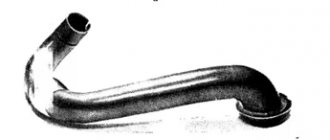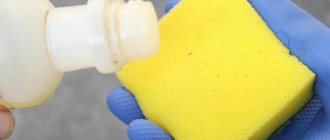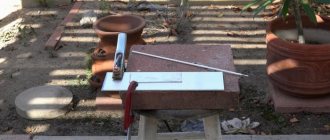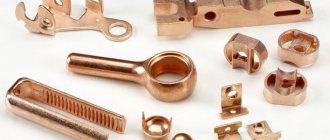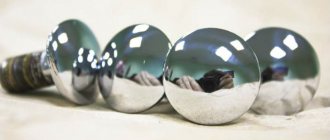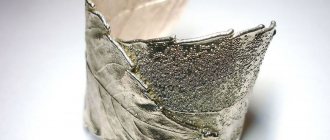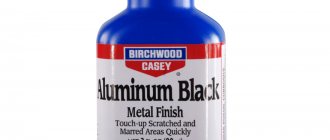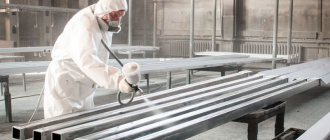The discovery of the galvanization method, made by the Russian physicist Boris (Maurice) Jacobi in 1838, separated into two independent branches of electroplating technology: electroplating and electroplating. Electroplating on an industrial scale allows the use of this electrochemical process of deposition of metal cations on any surface. Electroplating at home will help you obtain such a coating on the selected substrate.
Galvanic coating of products
Process Features
Using galvanoplasty, exact copies of any object are made. This technique is used in making bronze figures, printing plates, and restoring the surfaces of damaged parts.
The essence of the process is to immerse an object in an electrolyte. An aqueous solution of the metal salt that needs to be coated is used as an electrolyte. When salts are dissolved in water, the molecules in them break up into charged particles of opposite charges:
- metal or hydrogen cations are positive ions;
- Anions of acidic residues, hydroxyl groups or oxygen are negative ions.
As you know, electrolytes conduct electric current. If metal electrodes connected to a direct current source are immersed in them, current will flow through the electrolyte. In this case, positive ions will begin to move towards the cathode, negative ions will move towards the anode.
Electroplating process diagram
Attention! When restoring parts using galvanic deposition, the part itself can act as a cathode, and a metal plate can act as an anode. Anodes can be either soluble or insoluble. The first ones are made of metal deposited on the part, the second ones are made of lead.
As a result of the flow of current through the solution, the metal settles on the surface of the part (cathode) due to the fact that the metal and hydrogen cations on it lose their charge. The coating is applied at the molecular level. The anions, in turn, are discharged at the anode, releasing oxygen. The concentration of the electrolyte remains constant all the time, because the metal on the anode dissolves during the discharge and replenishes the solution with its positive ions.
Electroplating, as a type of electroplating technology, allows for protective and decorative coatings of metal products or imparting special properties to their surface. Its technological scheme involves applying a coating of another metal to a metal surface, which is more resistant to mechanical and chemical loads.
Purposes of Metal Electroplating
There are a variety of purposes for electroplating. For example, for galvanic chrome plating, the surface must first be coated with nickel. Electroplating is usually used to improve the decorative and protective qualities of structures. This procedure is also used to make exact copies of complex elements. In this case, the process is usually called galvanoplasty.
The technology of galvanizing metals through galvanization is widespread. It allows you to create a zinc coating on the surface, which is characterized by excellent anti-corrosion properties. Products made of metal alloys that have been processed using this technology can retain their properties for a long time at high humidity and even with constant exposure to salt and fresh water. Galvanizing is also used to process pipe products, all kinds of containers, support and building structures. Thanks to the use of galvanizing, metal surfaces receive both electrochemical and barrier protection.
If galvanizing only increases the resistance of the material to corrosion, then galvanizing with chromium solves this problem, making the surface more wear-resistant and stronger and also improving its appearance. Nickel-based galvanic coatings have a similar effect.
Another area of application of electroplating is the jewelry industry. This technology in this situation is used to improve the appearance of jewelry. In this case, a layer of silver or gold is applied to the jewelry. In addition, the film that is applied to the product during processing makes it brighter and more attractive.
Necessary equipment
Electroplating
Galvanic processing of small products at home requires certain equipment and chemical reagents. The main list of equipment includes:
- DC power supply;
- capacity;
- electrolyte;
- scales;
- electrodes “anode” and “cathode”;
- the wire;
- electric stove.
The source is used with current regulation. The rectifier, designed for output currents up to 5 A, is suitable for working with objects the size of an orange. For small cells, a current of up to 0.5 A is sufficient. 12 V chargers are also suitable for the electroplating process. The starter battery can serve as such a current source. To reduce the current, it is permissible to use shunting, connecting a resistor in parallel with the vessel.
When making a galvanic bath with your own hands, it must be spacious, durable and thermally stable. Ready-made glass products with a glass thickness of at least 4-5 mm, an old aquarium or a jar with a wide neck are well suited for these purposes.
Electrolyte is an aqueous solution of salts, prepared from chemical components depending on the desired coating.
To accurately select ingredients and maintain the proper concentration of the solution, you need a weighing device, preferably electronic.
Plates made of a donor metal of sufficient thickness and area are used as electrodes. The electrodes supply current to the electrolyte and also serve to replace the metal that is lost in it. The wires are multi-core, copper insulated, with a cross-section of at least 2.5 mm2.
An electric stove is required to heat the electrolyte. Increasing the temperature of the working solution speeds up the galvanization reaction time. The ability to adjust the heating is a prerequisite for selection.
Electroplating at home
Functions
Galvanic coatings are divided into several types depending on their purpose:
- Protective . Used to isolate metals from the effects of aggressive environmental factors.
- Protective and decorative . In addition to protective, they have an aesthetic function.
- Special purpose . Galvanization is used to give products new properties, for example, improving performance characteristics, restoring the original shape and size of products.
How to properly prepare the product for the procedure
Supercapacitor
Items to be galvanized must have a surface free of corrosion and dirt. The surface is cleaned to a shine by manual mechanical cleaning or grinding devices. Sinkholes and deep untreated scratches should not remain on the part. Otherwise, the atoms will not be able to form a good bond during galvanization and will precipitate. After machining, you need to immerse the part in a strong alkaline or acidic solution. You can use a short-term polarity change on the installation. Steel parts are immersed for several minutes in sodium phosphate heated to 90 degrees. Copper or its alloys are cleaned with soda or any detergent. You can also use sodium phosphate, but not heated.
Safety requirements
When working with electrolyte during electroplating at home, you must adhere to a number of requirements. The following factors are dangerous:
- release of harmful vapors when heating the electrolyte and its chemical reactions;
- danger of electric shock if the equipment circuit is not grounded;
- destruction of plastic baths when exposed to temperatures.
For protection, work must be carried out in a separate ventilated area. Be sure to use safety glasses, an apron, rubber gloves and a respirator. Eating food and water during activities is prohibited.
Types of electroplating
So, we looked at the basics of electroplating - we learned the chemical basis of this process, we understood how to assemble a bath, and we studied the safety rules. Let's now find out how electroplating is done at home. In our review we will look at 4 main galvanization technologies - chrome plating, galvanizing, nickel plating and silver plating. Some people also perform copper plating and brass plating at home (brass is an alloy based on copper and zinc). However, for full brass/copper plating, cyanide salts are required, which during electrolysis release particularly toxic hazardous substances. Therefore, we will not consider this procedure in this review.
Chrome plating
When chrome plating, a thin layer of chromium is created on the surface of the part. The chromium-based coating perfectly protects the part from rust, and also improves its thermal conductivity and chemical inertness. Another useful function of chrome plating is decorative (chrome has a pleasant metallic sheen that pleases the eye). You cannot do deep chrome plating at home. This requires high current (100 amperes and above). However, you can do surface chrome plating to improve the physical and aesthetic properties of the spare part.
Chrome plating stages:
- Before chrome plating, it is recommended to apply a protective layer based on copper and nickel to the surface of the spare part. This can be done using nickel plating operations. Why are these procedures needed? The explanation is simple - due to the chemical properties of the substance, chrome coating has a porous structure. This reduces the adhesion of chromium ions to the surface of the part. Nickel or copper reduces porosity, which improves the adhesion of chromium to the surface of the part.
- After nickel plating, you can begin chrome plating. To do this, you will need anode plates based on lead (93-95%) and tin/antimony (up to 7%). As an electrolyte, use a mixture of chromic (250-300 g) and sulfuric acids (2-3 g), the optimal temperature for heating the electrolyte is 50-60 degrees. The operation time is 30-50 minutes. Upon completion of the procedure, it is recommended to rinse the spare part in a weak soda solution.
Galvanizing
To increase the strength of the spare part and protect it from corrosion, a galvanizing procedure can be used. As the name implies, during galvanizing, the part is coated with a thin layer of zinc. The galvanizing operation is the simplest from a technological point of view. To carry it out, you need a small amount of zinc electrolyte (the main source of zinc will be the anode plate). The galvanizing procedure looks like this:
- Prepare an electrolyte - dissolve 175 g of zinc sulfate in 1 liter of water, add 30-40 g of ammonium sulfate and a little sodium acetate (10 g).
- Immerse the anode with a zinc plate in the prepared electrolytic solution. The plate dimensions may be small.
- Immerse the galvanizing part in the solution and turn on the DC power source. Galvanizing time is 50-60 minutes. The electrolyte for galvanizing does not need to be heated.
Nickel plating
Nickel plating allows you to obtain a pleasant reflective coating on the surface of the part. From a chemical point of view, nickel is an inert substance, so a nickel coating will protect the product from water and light chemical toxins. Nickel plating (like galvanizing) is a simple technological operation, and a beginner can handle it. The procedure looks like this:
- To prepare the electrolyte, mix the following substances - an aqueous solution of sodium sulfate (300 g), an aqueous solution of nickel chloride (70 g), pure boric acid (50 g).
- Heat the electrolyte to a temperature of 50-60 degrees, place the spare part in the electrolytic solution, set the generator to a current of 3-5 amperes.
- Carry out the treatment for 50-60 minutes. Please note that nickel fumes are toxic, so be sure to wear gloves, a mask or goggles on your face.
Silvering
Allows you to obtain a thin durable layer of silver on the surface of the spare part. Silver plating can also be done to increase the electrical conductivity of the part. For economic reasons, this procedure is rarely performed (silver is an expensive material). The silvering procedure is performed as follows:
- It is better to buy electrolyte for silvering in a store, since preparing it yourself will not be easy (and expensive). Although, if you wish, you can make it yourself by mixing clean water, silver chloride, ferric potassium cyanide and soda ash.
- Pour the electrolyte into the bath. If the air temperature is below 20 degrees, heat the electrolyte to this temperature using an electric stove.
- Place the spare part in the electrolyte bath. Carry out silvering for 40-50 minutes. Upon completion of the procedure, you can wash the product in a weak soda solution.
- Do not forget about safety rules, since potassium ferric cyanide releases hazardous substances during electrolysis.
Materials that cleaning chemicals cannot remove
Particles of various materials or defects present on the cathode being prepared may not be removed by chemicals. These include the following items:
- welding solder residues and slag;
- drops of various resins or their residual coatings;
- deep damage in the form of burrs or uneven edges;
- layers of burnt fat or remains of enamels and paints.
It is unacceptable to start working with the product until foreign inclusions or coatings have been completely removed.
Electroplating at home with muric acid
Muria – from the Latin muria “brine, salt solution”. There is no such element in the periodic table. This is what chemists called chlorine gas Cl2. Muric acid is hydrochloric acid HCl. It is similar to sulfuric acid and is colloquially called soldering acid.
The process of electroplating in hydrochloric acid using a copper anode looks like this:
- A steel workpiece and a piece of copper are connected to the supply terminals, observing the polarity (the workpiece is connected to the minus, the copper to the plus);
- the bath is filled with electrolyte: water and hydrochloric acid – 5:1;
- both elements are immersed in the solution, the clamp on the part is attached to a place where galvanization is not needed, or is constantly shifted during the coating process;
- the solution is periodically mixed during operation to ensure uniformity of the layer.
Attention! When mixing the electrolyte, the acid is poured in a thin stream into the water, and not vice versa. Stir with a glass rod and safety glasses.
A certain distance is maintained between opposite electrodes to avoid areas of rapid copper deposition. The product will be covered with a thin coating; it is difficult to achieve a thick layer. The time required for coating can reach several hours.
Advantages and development history
This technology was invented in 1838 by a scientist named Boris Jacobi . It was he who began the active introduction of galvanics into a variety of production processes. Soon, galvanic processing was successfully mastered by mints, artists, craftsmen, and industrial enterprises.
However, this technique received its name in honor of the Italian scientist Luigi Galvani. He began studying electrochemical processing technology almost simultaneously with Boris Jacobi.
The main advantages of galvanization include the following:
- Electroplated coatings are characterized by uniform thickness and the highest level of density.
- Electroplating can be easily applied even to structures with complex shapes.
- The coating resulting from galvanic treatment has good adhesion to many metals.
- The decorative and protective properties of galvanized parts are very high.
- The thickness of the galvanic coating is very easy to adjust.
By the way, the word “electroplating” is found not only in industrial fields and jewelry production, but also in cosmetology. This is the name of the process in which the skin is exposed to low-power currents to get rid of excess fat from the sebaceous glands.
Working with a metal ionic electrolyte solution
When galvanizing a house, the master needs to predetermine in advance what chemical reaction needs to be achieved. The material used for the anode and the composition of the electrolyte solution depend on this. The atoms that will be attached to the workpiece must be part of the electrolyte. Therefore, to obtain gold or silver plating, the electrolyte must have a gold or silver base. In the case of noble metal coatings, lead can act as an anode, but the electrolyte must be periodically renewed.
Galvanizing bath
To create a protective layer on the surface of a metal product, you will need electroplating equipment. The main element is a special galvanizing bath, which you can easily assemble with your own hands. Let's find out how to do this and what you need to remember:
- A galvanic bath is a container in which an electrolytic solution or a metal part to be processed will be placed. Therefore, the volume of the bath must be large enough for all the elements to fit into it. The volume of the bath must be selected directly for the part with a small margin so that the optimal amount of electrolyte fits into it (otherwise the reaction will proceed slowly or the galvanization will be of poor quality).
- Only plastic or glass containers should be used as a bath, since these substances are chemically stable and inert to electrolysis. Metal containers are completely prohibited - during electrolysis, metal ions will pass into the electrolytic solution, which will ruin the galvanization. It is also better not to use enameled metal products for electroplating, since during electrolysis there is a risk of damage to the enamel with subsequent transfer of metal ions into the electrolyte.
Electroplating for various metals
Zinc plating, brass plating, silver plating, nickel plating and chrome plating are all methods of coating one metal with another as a result of an electrochemical reaction. Depending on the desired result, you can obtain the required coatings at home using the same galvanic installation.
Nickel plating
This is the deposition of nickel atoms as a coating on the workpiece. Two nickel plates are taken as an anode and immersed in a bath of electrolyte at the same distance. Between them, a nickel-plating object is placed on a suspension. The sulfuric acid composition of the electrolyte includes:
- 140-200 g/l nickel sulfate (NiSO4);
- 50-70 g/l sodium sulfate (Na2SO4);
- 30-50 g/l magnesium sulfate (MgSO4);
- 5-10 g/l sodium chloride (NaCl);
- 25-30 g/l boric acid (H3B03).
All components are diluted with warm distilled water (20-25C0) in the required proportion. After dissolution, add water to the required volume. The acidity of the solution is 5.0-5.5 pH, with a flowing current density of 0.5-0.9 A/dm2. The minimum nickel plating time is 15-20 minutes. The thickness of the layer is directly dependent on the current strength, area of the part and exposure time.
Necessarily. Upon completion of work at home, the remaining electrolyte is washed off with running water, and the parts are wiped dry.
Nickel-plated parts
Chrome plating
Another shiny metallic finish is chrome. To prepare electrolyte for 1 liter of distilled water you need to take:
- chromic anhydride (CrO3) – 250 g;
- sulfuric acid (H2SO4) with a density of 1.83 g/cm3 - 2.5 g;
- distilled water, heated to 60 0C.
A current of nominal value is passed through an aqueous solution with an acid and anhydride mixed in it for 4 hours. until the electrolyte turns dark brown. After this, it sits for 24 hours and is ready for use.
Copper plating
Copper has a beautiful red hue. The part also acquires this color after galvanization. There are two options for copper plating: with and without immersion of the workpiece.
Immersion method
This is an already considered galvanization option with placing the part in an electrolyte solution. Copper plating is performed in the following sequence:
- 20 g of copper sulfate powder is added to the electrolyte for a car battery and mixed thoroughly;
- two copper sheets are lowered into a bath of electrolyte at a distance from each other, and the part to be copper-coated is placed between them;
- a direct current source with a voltage of 4-6 V is connected with its “minus” to the workpiece, and its “plus” - to the copper electrodes;
- The power supply regulator sets the current at the rate of 15 mA/cm2.
Process the part for 15-20 minutes. until the desired coverage is achieved.
For your information. Copper plating is used both as a separate decorative finish and as a preparation of the surface for further chrome plating or silver plating of the part. The method is also applicable for the manufacture of bimetallic structures.
Copper plating without immersion
In the case of surface processing of objects that do not fit into the container, this method can be used. Its essence lies in the fact that the part on which the copper layer will be applied is connected to the “minus” of a 6 V power supply (no more). A stranded copper wire, fluffed at the end like a tassel, is connected to the “plus”.
The “brush” is periodically moistened in the prepared electrolyte solution and the surface to be copper-coated is covered with it, while maintaining a minimum gap between the surface and the “brush”. Copper ions will be attracted to the negatively charged workpiece and settle on it. Alternatively, you can use a watercolor brush with a metal bristle clip.
Copper plating without immersion in a galvanic bath
Aluminum processing
Electroplating when working with aluminum objects at home is not practical. Aluminum and its alloys have a permanent oxide film that prevents the donor atoms from adhesion to the base. Even if it is removed, the increased electronegative potential of this element contributes to the displacement of aluminum ions from the surface even before the onset of electric current through the solution, which also interferes with the normal connection of the base with the coating; pre-galvanization will not help either.
Gilding and silvering
The mirror is a clear example of applying a silver coating to glass. Products made of copper, brass and their alloys are well susceptible to silver plating. At home, the workpiece is first coated with nickel, then silver-plated. The electrolyte solution for silvering includes:
- potassium iron cyanide – 40 g;
- soda ash – 40 g;
- ammonium hydroxide solution – 70 ml;
- silver chloride – 10 g;
- sodium chloride (salt) – 15 g;
- distilled water – 1 l.
A graphite construction pencil rod is used as an anode.
Do-it-yourself electroplating can also help you turn copper into gold by applying gilding. This is done in the following order:
- 60 g of sodium phosphate (Na₂HPO₄) is dissolved in 700 ml of distilled water;
- 2.5 g of gold chloride (Au₂Cl₆) is mixed in 150 ml of highly purified water;
- 1 g of potassium cyanide (KCN) and 10 g of sodium sulfate (Na₂SO₄) are diluted in 150 ml of water.
The resulting solutions are mixed and heated to 60 °C. At this temperature, the further gilding process takes place. To prevent electrolyte depletion, a lead anode is used.
Attention! The reagents are hazardous to health. When working, observe increased safety measures and use personal protective equipment. The galvanizing table must have forced local ventilation.
General information
Galvanization (galvanization) is a physical and chemical technology that can be used to create an additional layer of another metal on the surface of a metal. The thickness of the additional layer is small. Usually it ranges from 0.1 to 2-3 millimeters. Galvanization is used for many purposes - increasing strength, creating an anti-corrosion layer, and others. Only a metal surface can be coated with a galvanic layer. This could be dishes, car parts, engineering tools, decorative items. Metals act as a galvanizing layer - chromium, nickel, copper, silver, zinc + alloys based on them.
Electrolysis circuit
From the point of view of chemistry and physics, galvanization is carried out through a special process called electrolysis. In a simplified form, electrolysis of metal products looks like this:
- The surface of the spare part is cleaned of various contaminants (organics, dust, dirt, light corrosion). It is recommended to supplement cleaning with degreasing, since this procedure allows you to obtain a clean surface on which a thin galvanic layer of substances derived from the electrolyte will be applied.
- An electrolyte is placed in a plastic or glass container - a solution of alkalis, acids and salts containing the desired metal. For example, for electrolytic chrome plating, chromic acid is used, which during electrolysis releases chromium, which is transferred to the part. To improve galvanization, the electrolyte can be heated to low temperatures (usually no more than 60 degrees).
- A DC source is connected to the electrolyte (AC sources are not used as the operation will not start). Two wires are used for connection - cathode and anode. The cathode is attached directly to the workpiece, and the anode is placed in an electrolyte solution. The anode is usually supplemented with a plate of the appropriate metal, which enhances galvanization (for example, galvanizing requires a zinc plate).
- The workpiece is attached to the cathode, and then the cathode is placed in an electrolyte solution. The cathode with the spare part should not be in direct contact with the anode, since in this case a short circuit will occur or the galvanization will not start/will proceed slowly. The part being processed must be at a good distance from the anode with the plates for the operation to be successful.
- Now the electric current is turned on, which leads to the closure of the circuit. The current first enters the anode and then enters the electrolytic solution. This triggers a series of chemical reactions, as a result of which metal ions are released from the substance and begin to move along with the electric current towards the cathode. When passing through the cathode, these ions are deposited on the surface of the spare part, which leads to the formation of the desired coating. Galvanic processing of one part requires 20-40 minutes, depending on the size and shape of the part.
Core Technologies
The main electroplating technologies are chrome plating, silver plating, nickel plating and galvanizing, in which the part is coated with chromium, silver, nickel and zinc, respectively. In addition to this, there are other operations (for example, copper plating and brass plating). However, their implementation requires the use of cyanide salts, which are poisonous even for a person wearing protective clothing. Therefore, these procedures are usually performed in special workshops or workshops.
Features of electroforming
Using this method, objects are copied down to the smallest detail. Electroplating allows the production of products with complex configurations that cannot be reproduced in any other way. Fragile workpieces gain strength and a different appearance when coated with metal. The material of the workpiece does not matter, since it remains inside. The copy is as close as possible to the original.
Acorn pendant made by electroplating
The use of both types of electroplating at home allows for the production of decorative jewelry, protective coatings and simply beautiful things. A correctly selected electrolyte and a well-organized electrochemical process is all that is needed for this.
